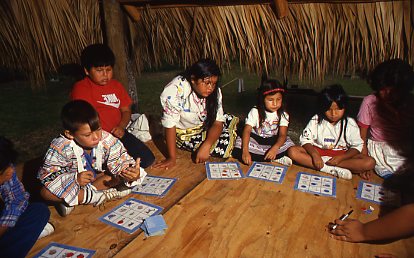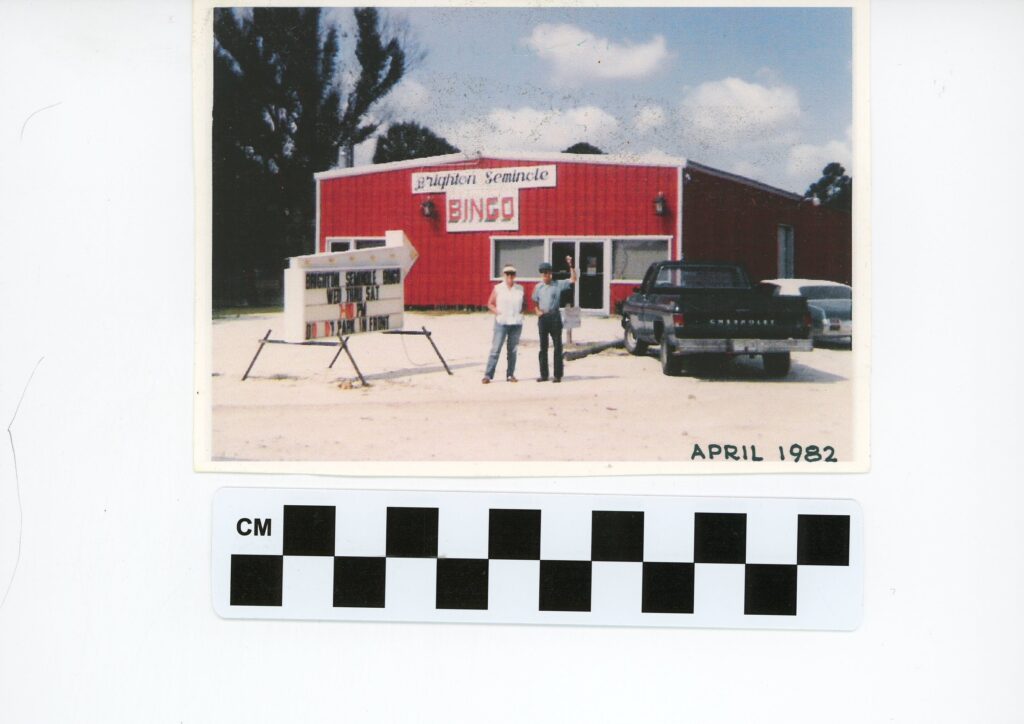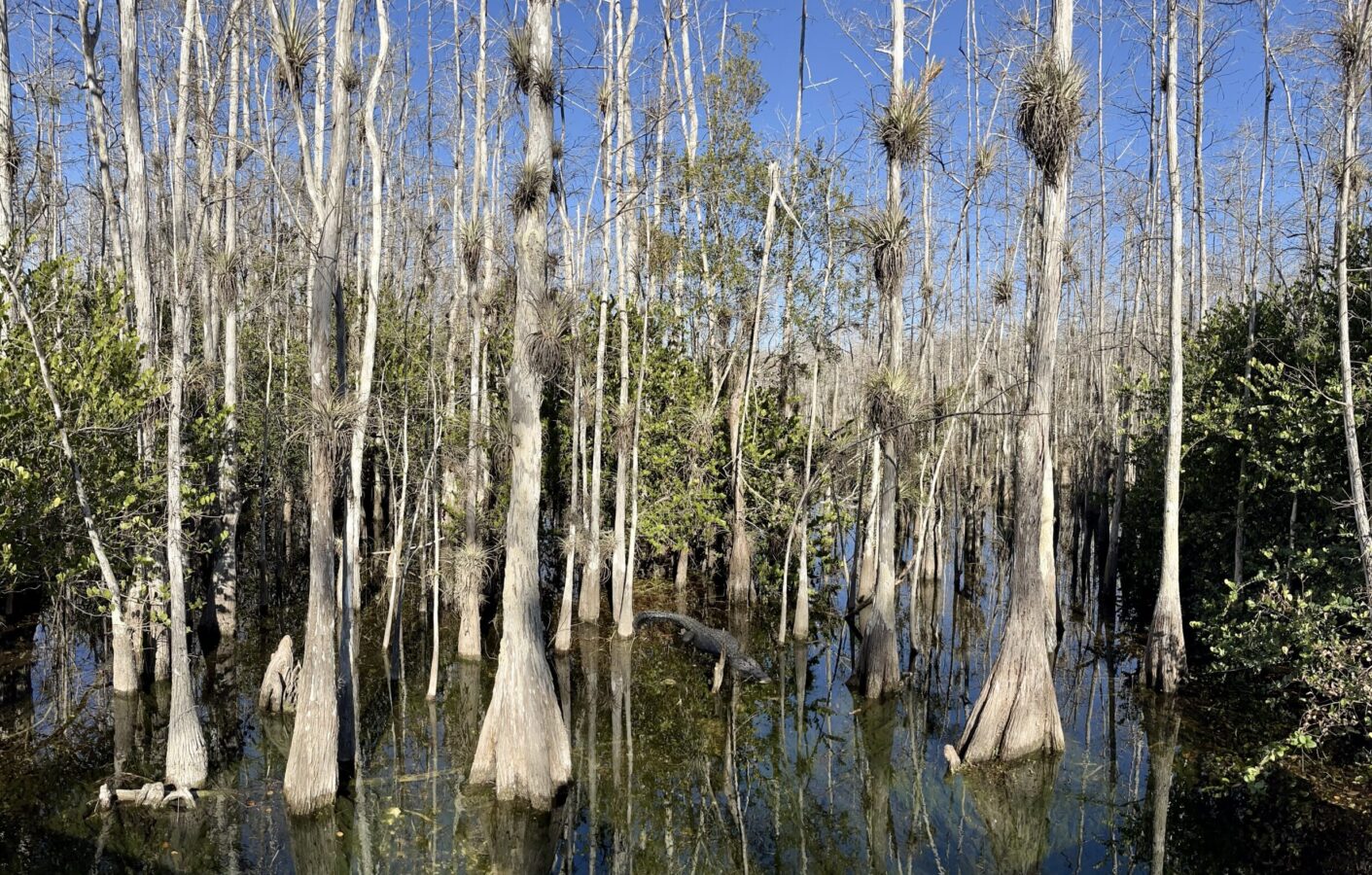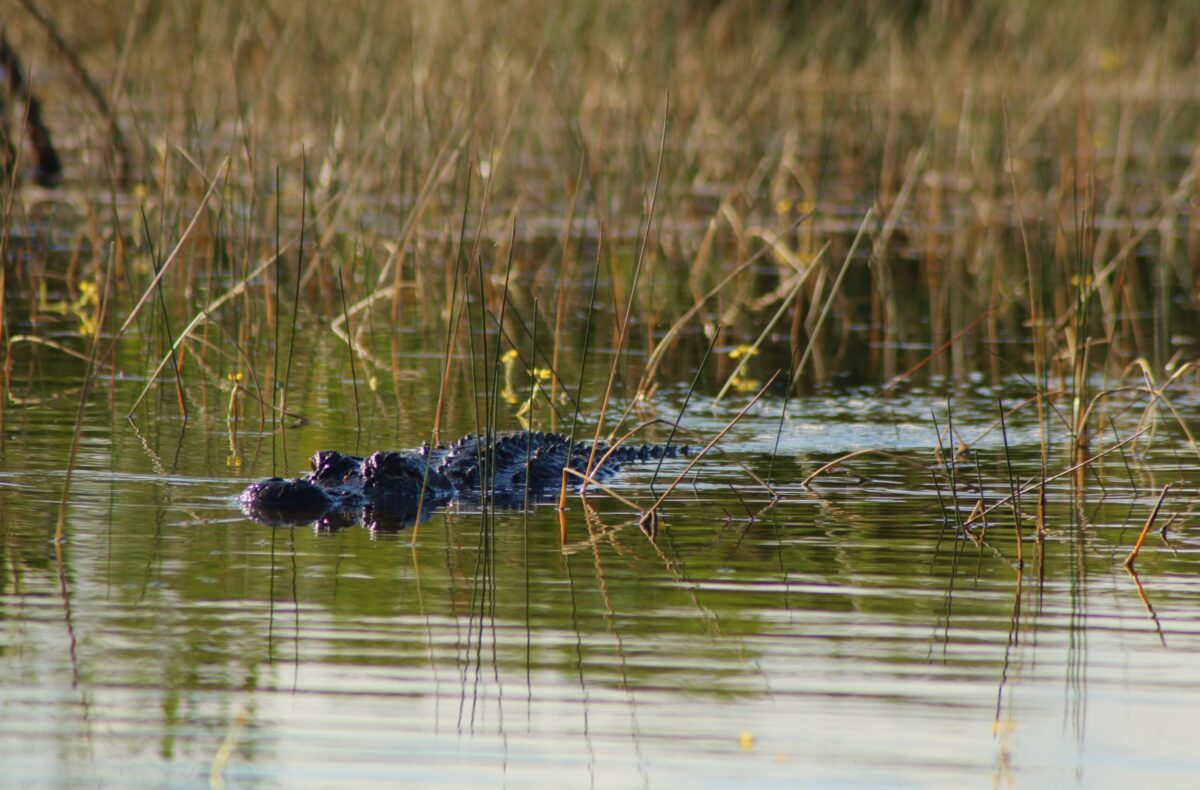
Seminole Bingo Booms in the 1980s
Welcome back to our series on Decades of Seminole Tourism! We are focusing on the 1980s, where Seminole bingo began to boom big in the Sunshine State. Building on the legal successes seen in the late 1970s and early 1980s, Seminole bingo begins to cement the Seminole Tribe of Florida’s fiscal stability throughout this decade. This week, learn how Seminole bingo exploded in the 1980s, and how it set the stage for the Seminole Tribe of Florida’s continued success.
Below, a group of children sit under a chickee, playing with a laminated card with pictures of animals on it. They have markers and paper chips, and are most likely playing a game of bingo. John J. Lopinot took this image in September 1987. Lopinot was an intern for the National Geographic on assignment at the Big Cypress and Brighton Seminole Indian Reservations at the time. In the 1980s, bingo hall revenue allowed many community programs, reinvestment projects, and services to flourish in the reservation communities. Bingo halls transformed the lives of the Florida Seminoles. The Seminole Tribe of Florida established senior centers, community centers, education programs, Seminole Cultural Education programs, and more services to support their members with funding from bingo revenue.

2021.24.260, ATTK Museum
The Seminole Tribe of Florida Wins Big in the Courts
Last month, we talked about the birth of bingo for the Seminole Tribe of Florida in the 1970s. The Seminole Bingo Hall, located in Hollywood and now the Seminole Classic Casino, was the country’s first large-scale bingo hall. Subsequently, the Seminole Tribe of Florida was the first federally recognized tribe to operate a bingo hall on a reservation. Opened in 1979, the Seminole Bingo Hall was the catalyst for the Seminole Tribe of Florida v. Butterworth, a legal ruling that would set the precedent for Indian gaming throughout the United States. It upheld the Seminole’s claim that their tribal sovereignty made them immune from legal interference on reservation land, skirting Florida’s restrictions on high-stakes bingo games. Decided in 1981, the United States Supreme Court also declined to hear Florida’s appeal to the ruling. The Supreme Court “held that the state permitted bingo, and merely regulated the content of such games.”
After this big legal win, tribes in other parts of the United States began to explore bingo as a means for financial stability. In 1985, the Seminole Tribe of Florida won another legal battle that would further uphold their sovereign rights. In Department of Revenue of the State of Florida v. The Seminole Tribe of Florida, the Florida Fourth District Court of Appeals upheld a lower court decision. This stated that the Florida State Department of Revenue could not sue the Seminole Tribe of Florida to collect sales tax from tribally owned businesses on reservations. This legal precedent would further uphold tribal sovereignty. Due to their numerous legal wins, the Seminole Tribe of Florida leaned in hard on the success of their first bingo venture. Soon, the Seminole Tribe of Florida would establish more bingo halls on reservation land.
The Big Cypress Seminole Bingo Hall
The Hollywood Seminole Bingo Hall was a massive success. It “recouped its $1.5 million start-up cost in less than a year. Since 1980, the hall…has earned a profit every year [by 1988]” (The Miami Herald, 23 August 1988). After the dramatic legislative win of the early 1980s, bingo gained traction in both the greater community and on the reservations. Seminoles saw it as an important opportunity to cement their economic stability. By the late 80s, many other Seminole Bingo Halls opened on reservation land. The 5,600 square foot Big Cypress Seminole Bingo Hall would open in 1987 with much fanfare. Bingo-goers were bussed into Big Cypress from cities around the US, lured by cash prizes up to $250,000. The Big Cypress Seminole Bingo Hall was set up for success.
But, unfortunately, this would not be the story for this bingo hall. Plagued by mismanagement and financial issues, the hall closed for the first time in 1988. The Big Cypress Bingo Hall would reopen and close a handful more times, before closing for good in the early 2000s. The Tribe finally demolished the building in 2020. Although the Big Cypress Seminole Bingo Hall flopped, the same can’t be said for the Hollywood, Tampa, and Brighton locations. At the time, Tampa and Hollywood were some of the most profitable in the country.
The Brighton Seminole Bingo Hall
The Brighton Seminole Bingo Hall, located just west of Lake Okeechobee, opened in 1982. The no-frills, sheet-metal shed bingo hall lacked glamour – but made up for it with big wins. People flocked to the rural bingo hall, where you could win big cash prizes. While not as popular as the Tampa Seminole Bingo Hall, the Brighton Seminole Bingo Hall still attracted many people with its large prizes and smaller crowds. Open four days a week, the bingo goers “more than doubles the reservation population on bingo nights” (The Bradenton Herald, 08 Aug 1982). Josiah Johns started bingo in Brighton when he added bingo tables to his hardware store and beauty parlor in 1980. Soon, the red-metal roofed building (below) was built to accommodate busloads of bingo-goers from the surrounding communities.
The success of the Brighton Seminole Bingo Hall was no surprise. In 1982, Johns emphasized the importance of the bingo hall, stating “We are not just playing around here. We mean business” (The Bradenton Herald, 08 Aug 1982). The management of Josiah and Lucy’s Seminole Bingo Hall passed to their son Marty in 1983. Below, you can see an exterior photo of the original Brighton Bingo Hall. Josiah Johns and his wife Lucy are standing in front of the building. There is a visible sign that reads “Brighton Seminole Bingo, Wed Thru Sat, 7-10pm, Park in front.” The photo was taken in April 1982, as noted by the handwritten label on the bottom right corner. The Brighton Seminole Bingo Hall flourished, and a new building was completed in 1999.

2018.15.126, ATTK Museum
Tampa Reservation Bingo Hall
The Tampa Reservation Seminole Bingo Hall opened in 1982, breaking ground only a few weeks after the Supreme Court ruling and associated appeals were finished. On opening day, more than 1,200 people waited hours to attend the first bingo games at the new hall. Busloads of bingo goers arrived from Fort Myers, Orlando, St. Petersburg Beach, Bradenton, Dunedin, Largo, and more.
At the opening, then-Chairman James E. Billie stated “We didn’t send out any reservations, but I figured once you got the idea, you’d be here!” (The Tampa Tribune, 02 June 1982). The Tampa Seminole Bing Hall was an immediate success. In our featured image this week, you can see an exterior shot of the Tampa Reservation Bingo Hall. In front of it, a Cadillac Coup de Ville is parked under a banner reading “Drive Me Home!” The picture was taken in 1983, and most likely the Cadillac was a high-stakes prize for bingo-goers.
The Tampa, Hollywood, and Brighton Seminole Bingo Halls brought in big revenue for the Seminole Tribe of Florida. By 1983, the Tribe “banked $2.7 million in profit” from bingo (The Bradenton Herald, 05 June 1983). Below, you can see another exterior shot of the Tampa Reservation Bingo Hall and Gift Shop, taken in 1983. At the time, the Tampa Reservation was a very new reservation, established only in 1980. In addition to the high-stakes bingo hall, the Seminole Tribe of Florida opened a museum and smoke-shop.

The Indian Gaming Regulation Act of 1988
With the continued success of bingo in Florida, there were increasing pressures in the federal government to attempt to regulate these ventures. In 1988, Congress began considering a bill to regulate and tax Indian bingo and gaming. Once again, the Seminole Tribe of Florida was at the front of this new legal battle. Jim Shore, the Seminole Tribe of Florida’s general legal counsel at the time stated “If you wait for the federal government to plan your destiny, you’ll have to wait a long time. You have to use your imagination and take risks, and that is what the Seminoles claim to fame is – being able to take risks on business opportunities” (The Miami Herald, 23 August 1988). At the same time, the Seminole Tribe of Florida was weighing their options on expanding from bingo halls to casinos. In 1986, Florida voters considered legalizing full-scale casino gambling.
Speculation about Seminole Tribe’s plans to expand to casino gambling ran rampant in the media, although the amendment was rejected. At the time, the Tribe did not intend to shift straight to casinos. Before the vote for the amendment, the Seminole general legal counsel Jim Shore spoke on the issue. Shore emphasized that “the tribe members may have opposition to casinos… There may be some for it and some that don’t care. But people shouldn’t automatically jump to the conclusion that if the state does it, the tribe does it” (The Miami Herald, 20 Sept 1986).
While that specific amendment didn’t see daylight, the Indian Gaming Regulatory Act (IGRA) of 1988 would. The IGRA placed certain stipulations on Indian gaming, and how the states interacted with gaming. But, states were able to effectively regulate themselves. The state alleged that Indian gaming was attractive to organized crime. The Court replied “we are unconvinced that it is sufficient to escape the pre-emptive force of federal and tribal interests apparent in this case.”
Bingo Paves the Way…But not yet!
Thus, the federal courts decided that tribes had exclusive rights to regulate gambling activity on reservation land, if the games were already legal in the state.. It also delineated between different types of gaming, organizing them into Classes. Casino-style gaming, which included slot machines, poker, and blackjack, were classified as “Class III” (Fletcher 271). The IGRA required tribes and governors to negotiate a compact in order to operate these types of games if they were legal in that state, where governors were required to act in good faith. This obligation would be the underpinning of the IGRA, opening the tribe’s rights to sue if the obligation was violated. In Florida at the time, poker, betting, and roulette were legal, while slot machines and blackjack were not. Soon, push and pull between the state and the Seminole’s desire to expand would extend to these casino style games.
At the end of the 1980s, the IGRA would signal the further expansion of the Seminole Tribe of Florida’s gaming opportunities. It also would lead to more legal battles, as the Seminole Tribe would dip their toes into casino expansion soon after. Eventually, the Seminole Tribe of Florida would become the casino powerhouses we know today. But, it all began with bingo.
Interested in the rest of our Decades of Seminole Tourism series? Check out previous blog posts on the 1900s, 1910s Part 1, 1910s Part 2, 1920s, 1930s, 1940s, 1950s, 1960s, and 1970s.
Additional Sources
The author accessed these sources digitally. Page reference numbers may not align with paper and hardback copies.
Fletcher, Matthew L.M. The Seminole Tribe and the Origins of Indian Gaming, 9 FIU L. Rev. 255 (2014).
West, Patsy. The Enduring Seminoles: From Alligator Wresting to Casino Gaming, Revised and Expanded Edition. 2008. University Press of Florida. Digital.
Author Bio
Originally from Washington state, Deanna Butler received her BA in Archaeological Sciences from the University of Washington in 2014. Deanna moved to South Florida in 2016. Soon, she began working for the Seminole Tribe of Florida’s Tribal Historic Preservation Office. Deanna was the THPO’s Archaeological Collections Assistant from 2017-2021. While at the THPO, Deanna worked to preserve, support, and process the Tribe’s archaeological collection. She often wrote the popular Artifact of the Month series, and worked on many community and educational outreach programs. She lives in Fort Myers, FL with her husband, son, and dog.



